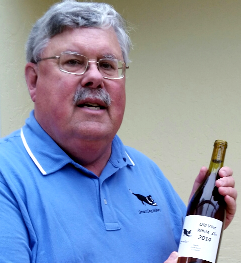
Smart Dog WineryTM
a smart dog can sniff out a good wine
Working with Grapes
After kits comes grapes!
You can actually start part way using pre-picked and
crushed-destemmed grapes in containers.
The most available versions are frozen and can be shipped
almost anywhere. You
deal with them similar to kits (see Kit wines), but with red grapes
you will probably need to press them after primary fermentation.
Also, you will get less wine from a similar start volume due
to the skins and seeds.
After that
comes working with raw grapes, and picking them (if you live in an
area where they grow). Following
working with kits I then began with self-picked grapes.
I picked in
the morning of 1 October 2011.
It was cool and slightly overcast when I started, but I was
hot and sweaty at the end, temperature still under 70 degrees, but
it felt a lot warmer to me. Picked about 200 pounds, and then was
running out of space to hold more, and was running out of me. Grape
harvesters do not make near enough money for the work they do.
When doing your own picking, select your row and go as far down the
row as you think you will pick, then 30 to 50% farther. Start here
and pick towards the start, because that first bucket weighs a whole
lot less than the last one will, and it will be a lot fuller too.
You will also find that you are lot more selective on the clusters
that you pick at the beginning than at the end.
Following
picking comes the next part, you now have 1 or more large containers
of grapes.

It is also
possible to get your grapes pre-picked, inrelatively easy to handle
totes (often 30-36 pounds each).

The next
step is crushing-destemming, which requires some special equipment
called a crusher-destemmer!

A
crusher-destemmer is probably the most expensive piece of equipment
you will own. And while
they can often be rented (and I did at first) the timing is critical
and you may need to plan your picking around its availability.
To operate
the grape stemmer crusher:
As grape
clusters are fed into the hopper on top, a stainless steel auger
moves them towards the crusher rollers. The grapes, along with the
stems, then drop through the rollers, falling below to where the
destemmer basket is located. A second auger fit with destemming
paddles runs through the middle of the destemming basket then moves
stems in the opposite direction of the hopper auger above. The holes
in the basket allows grapes to pass through but not the stems. The
crushed grapes will drop straight down from under the crusher
rollers, while the stems will drop out from the opposite end of the
unit, where the destemmer cage ends.
Tips on its
use
1. Clean and
Sanitize before use.
2. Set up in
a place that can be easily cleaned.
3. Set up
the machine in a secure position before turning on.
4. Always
use a heavy-gauge (14 Gauge or thicker) commercial quality extension
cord.
5. Turn on
the machine and make sure everything turns freely.
6. NEVER
reach into the machine while it is running.
7. Feeding
the machine in a consistent, steady flow will offer a better crush
with less issues.
Following
crushing-destemming is pressing.
Either before fermenting (white & rose’) or after primary
fermenting (reds). For
this you need a press, and no using your feet is not recommended.

A
wine press is used to separate the juice or fermented wine
(depending on if you're doing reds or whites) from the skins, seeds
and pulp that make up the solid parts of the grape. This is done by
squeezing. You will basically be choosing between the nicer
features of a bladder press or the low price of a basket press, then
selecting the appropriate size for their needs.
There are two basic styles of wine presses that are available to
the home winemaker. The first being the basket or ratchet design and
the second being the bladder design. Both are equally effective in
squeezing the juice from the pulp.
Basket Presses: Basket
Presses work by squeezing the grapes or must from the top and
bottom. The must or whole bunches of grapes are placed inside
the wooden basket until it is pretty full, often with a mesh bag to
keep seeds and other particles out of the wine.
Then the top is covered with
wood or steel plate and pressure is applied by a rachet or jack. By
nature, working this way yields one of two results: 1) In order to
get every last drop of wine/juice out of the grapes the customer
ratchets down pretty hard on the fruit. This causes extra pressure
to be put on the seeds and any stems present, extracting harsh or
bitter flavors into the wine; or 2) In order to avoid these
undesirable flavors, the customer does not ratchet down so hard on
the fruit. As a result, they leave behind perfectly good wine
or juice.
Bladder Presses: Bladder Presses work by squeezing the must or
grapes from the inside (center of the press) outward. As a
result of this the entire lot of fruit receives the same amount of
pressure during pressing, meaning the customer does not have to
choose between maximum yield and maximum quality.
Additionally, bladder presses are faster to run per press cycle.
That means that the customer can purchase a smaller press then they
would need to with a basket press and simply run it more times in a
day, which in turn means that the press is easier to store the rest
of the year. Bladder presses are also easier to use and to move
around.
From
this point it is pretty much the same as with kits.

Or my excursion into winemaking
